Is there a simple nutrient to reduce blood pressure and promote heart health? Let’s delve into the world of this potent remedy and health strategies!
In the battle against high blood pressure, dietitians are championing one unsung hero: potassium. Nearly half of U.S. adults grapple with high blood pressure, a condition deeply entwined with dietary choices.
What Is The Top Nutrient To Reduce Blood Pressure Advised by Dietitians?
Potassium, a vital mineral and electrolyte, takes center stage in this health drama by relaxing blood vessel walls, thereby lowering blood pressure and safeguarding heart health.
Potassium, found in abundance within cells and body fluids, orchestrates a symphony of bodily functions. Beyond blood pressure regulation, it supports heart rhythm, bone health, and metabolism.
However, Americans often favor sodium-rich diets, tilting the balance toward hypertension. The ideal potassium-to-sodium intake ratio stands at 2-to-1, yet research reveals most Americans are closer to a problematic 1-to-2 ratio.
The dynamic duo of heart health, potassium, and sodium work hand in hand. Sodium can lead to water retention and elevated blood pressure, while potassium promotes sodium excretion through urine and relaxes blood vessels.
Here are six tips to boost potassium intake:
- Load up on Fruits and Veggies: Bananas are famous for their potassium, but so are oranges, potatoes, sweet potatoes, apricots, kiwis, tomatoes, spinach, and cantaloupe. Fresh, canned, or frozen, these foods should grace your plate.
- Embrace Leafy Greens: Spinach, kale, and Swiss chard contain substantial potassium. Incorporate them into salads, omelets, or smoothies for an effortless potassium boost.
- Keep Potato Skins: Don’t discard potato skins; they house most of the potassium. Enjoy a baked potato with its skin for a potassium-packed meal.
- Blend in Smoothies: If eating enough fruits and veggies is a challenge, blend them into a smoothie. A medium frozen banana, milk, and half an avocado can provide 27% of your daily potassium needs.
- Greek Yogurt Snacks: Greek yogurt, with its potassium, probiotics, and protein, is a heart-healthy snack. Opt for unsweetened versions and customize with fruits or natural sweeteners.
- Fatty Fish Favorites: Salmon, sardines, and mackerel, rich in omega-3 fatty acids, maintain potassium levels and support heart health. Canned salmon is a convenient alternative.
In summary, with high blood pressure affecting so many, integrating potassium into one’s diet is crucial for heart and blood vessel health. This mineral’s magic lies in relaxing blood vessels, counteracting sodium’s potential harm, and maintaining fluid balance.
A diet rich in potassium-packed whole foods is the key to achieving a harmonious blood pressure and a healthier heart.








Leave a Reply
You must be logged in to post a comment.